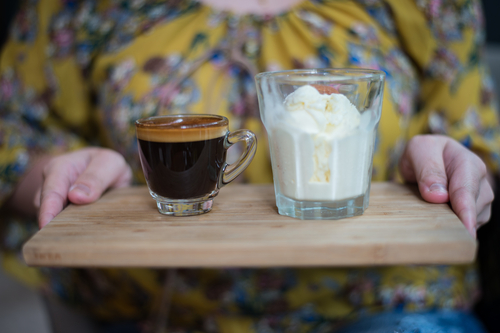Culture August 30, 2017
The best part of waking up is espressos in your cup.


On National Espresso Day, November 23rd, coffee connoisseurs all around the country wake up to pour themselves a cup of coffee. This time, though, it’s not just your regular cup of Joe. It’s an espresso.
The espresso graces many cup-holders because of its thick texture and foamy topping.
In honor of National Espresso Day, ENTITY shares how the espresso came to be.
Cafes were booming all over Europe in the 18th-19th centuries, but coffee brewing was actually just gradually making its way in. One of the biggest issues about coffee in the early 1900’s is the waiting time it took to brew. Countless customers would stand in line and wait for almost an eternity.
The race was on to find a better, faster way to brew coffee by inventors all over Europe. Finally, a man named Angelo Moriondo from Turin, Italy was granted the patent to the first espresso machine in 1884. It didn’t stop there though.
Inventors Luigi Bezzerra and Desiderio Pavoni decided to take Moriondo’s invention up a notch. Both made improvements to the espresso machine by adding multiple brewing heads and a large boiler. The espresso was later popularized by a man named Desiderio Pavoni who showcased the espresso machine at the 1906 Milan Fair.
These early machines could produce 1,000 cups of coffee per hour.
First and foremost, a majority of Italians do not favor the American espresso. Augusto Marietti, a born and raised Italian, says that it has to do with the water and poor quality of products.
“Water quality is probably the biggest factor on why coffee, pasta and pizza taste better in Italy. The water has more calcium and a different combination of minerals; additionally, Italy has less added chlorine (the Bay Area has a strongly chlorinated water),” writes Marietti.
Italy is so serious about their coffee that INEI are trying to preserve old brewing styles by offering certificates to those who do it “right.”
The Italian Espresso National Institute says that they are taking measures to protect their coffee brewing culture.
“International chains of cafes are spreading, calling the coffee they serve Italian espresso. But, behind our espresso… there is a unique and unrepeatable culture,” shares INEI’s chairman Luigi Zecchini.
Italian master barista Giorgio Milos says a truly good espresso involves having tastes be in harmony.
“A good cup of espresso has to be balanced between sour, bitter and sweet,” shares Milos. Milos also says that it’s okay to have variations of the espresso, but explains that you need to always go back to the basics.
He says, “But in order to create something new, you have to follow the baseline, to know how to do something the real way. Then try to do something different. In Italy, we have a saying: Learn to walk before you run.”
A San Franciscan barista disagrees with Milos when it comes to coffee.
“American baristas no longer look to Italy for context,” says the anonymous source.
Americans rarely drink espressos though. The go-to drink for Americans is lattes, cappuccinos and regular coffee. In regards to how much Americans drink, the average American drinks 2.1 cups of coffee per day. Research also shows that coffee consumption goes up as you get older.
Coffee does have a good number of benefits. The benefits being that it is rich in antioxidants and it can boost your metabolism. But medical Doctor Mark Hyman says that having a large amount of caffeine in your cup of Joe can affect your health negatively.
Hyman writes, “The caffeine in coffee increases catecholamines, your stress hormones. The stress response elicits cortisol and increases insulin. Insulin increases inflammation, and this makes you feel lousy… High blood sugar levels lead to arterial deterioration and increased risk of mortality related to cardiovascular disease.”
Remember the best drink to have to start your day is a healthy one.